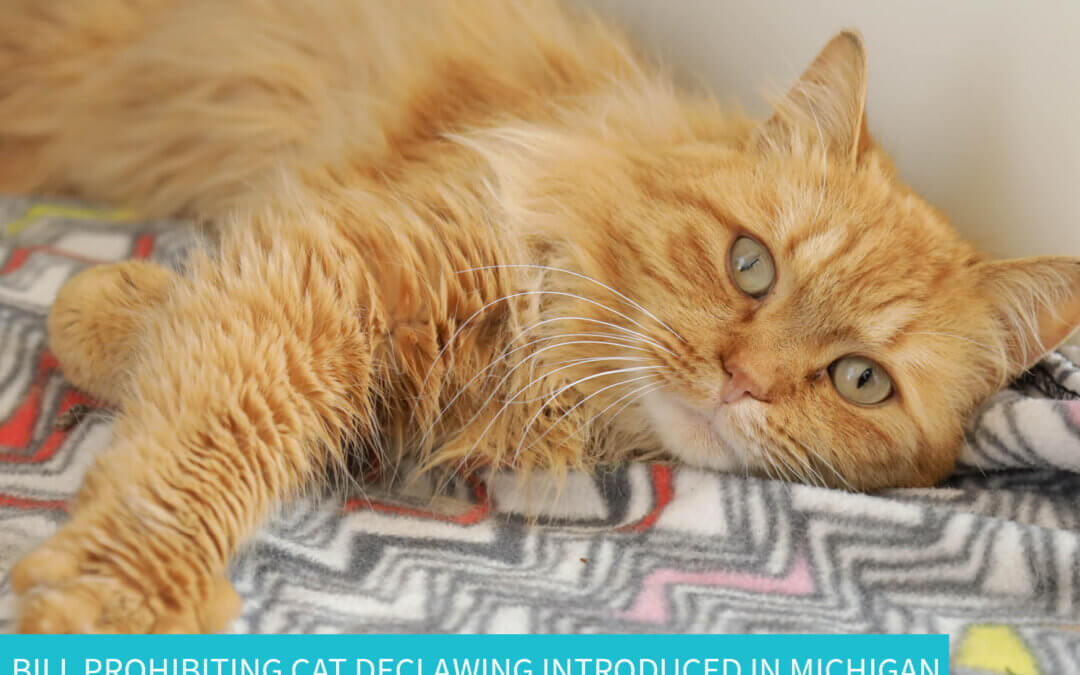With the introduction of HB 6459, Michigan is again considering legislation that would ban the declawing of cats unless required for a therapeutic purpose. Violations would be punishable by a civil fine of up to $1000. The bill was introduced by Rep. Yousef Rabhi, who cosponsored a similar bill in the 2019-20 session. It is unlikely that the bill will make significant progress this legislative session, which ends on December 31, 2022. However, it is good that this important bill was introduced because it will raise awareness of this issue and may increase the likelihood of the bill being reintroduced in the 2023-24 legislative session.
What is declawing?
Scratching is a normal, instinctual behavior that cats do to condition their claws, mark territory, stretch, and tone muscles. Surgical procedures, typically referred to as “declawing” procedures, are sometimes seen as a solution to scratching behavior in the home that causes damage. But contrary to what the name implies, the procedures involve more than the removal of the claws.
Unlike human fingernails, which grow from the skin, cats’ claws grow from the bones in their toes. Onychectomy and phalangectomy are declawing procedures that involve an amputation of the last bone of each of the cat’s toes. An equivalent procedure on a human would involve cutting off his or her fingers at the last joint. These surgeries are traditionally performed with a scalpel, guillotine clipper, or laser.
Another procedure, which is performed to prevent cats from using their claws, is the tendonectomy. In a tendonectomy, the tendons controlling the cat’s claws are severed. The cat’s claws are retained but the cat cannot control them.
Michigan HB 6459 would prohibit the performance of an onychectomy, a partial or complete phalangectomy, or a tendonectomy unless the procedure was being performed for a therapeutic purpose.
What are the potential risks of declawing?
Onychectomy, phalangectomy, and tendonectomy all come with physical and behavioral risks. As with any surgery, there are risks associated with general anesthesia and the potential for surgical complications, such as bleeding, infection, lameness, nerve and tissue damage, and death. These procedures can all result in acute and chronic pain. Tendonectomy can result in abnormal claw growth, requiring frequent nail trims.
According to a report published in the Journal of the American Veterinary Medical Association, 33% of cats undergoing an onychectomy, phalangectomy, or tendonectomy surgery experience at least one behavioral problem, including an increase in biting frequency or intensity and not using the litterbox.
What are humane alternatives to declawing?
There are several humane alternatives to declawing that will prevent a cat from causing damage by scratching. These include:
- Trimming the cat’s nails every two to three weeks.
- Providing appropriate places for the cat to scratch that are more attractive than the furniture.
- Making furniture and other places the cat shouldn’t scratch less attractive by covering the spots with a sheet, tinfoil, double-sided sticky tape, or vinyl carpet runner with the spike side up.
- Applying vinyl caps to the cat’s nails.
Where is declawing illegal?
The Michigan bill is patterned on a New York statute. New York was the first state to ban declawing. New York’s ban passed in 2019. Maryland recently became the second state to enact a ban on cat declawing, which went into effect on October 1, 2022. Declawing is also banned in a number of major cities in the U.S., including Los Angeles, San Francisco, Denver, St. Louis, Austin, Pittsburgh, and Madison.
The U.S. is behind other countries in terms of legislative bans on declawing. Declawing is illegal in Brazil, Israel, Australia, New Zealand, and most of Europe. Eight out of ten Canadian provinces have banned declawing. While legislative bans on declawing are just starting to be introduced in the U.S., many U.S. veterinarians refuse to perform the procedure.
What is Michigan Humane’s position on declawing?
Michigan Humane will not perform any surgery on an animal that does not have a direct medical benefit for the animal, including onychectomy, phalangectomy, and tendonectomy, and supports a legislative ban on all medically unnecessary surgeries.
We are going to keep working to improve animal welfare and create a more humane community while serving as a voice for the animals through advocacy. Together, we can continue to make a difference in animals’ lives. If you know someone who you think would be interested in this information, please forward this to them and encourage them to sign up for our Legislative Action Network.

